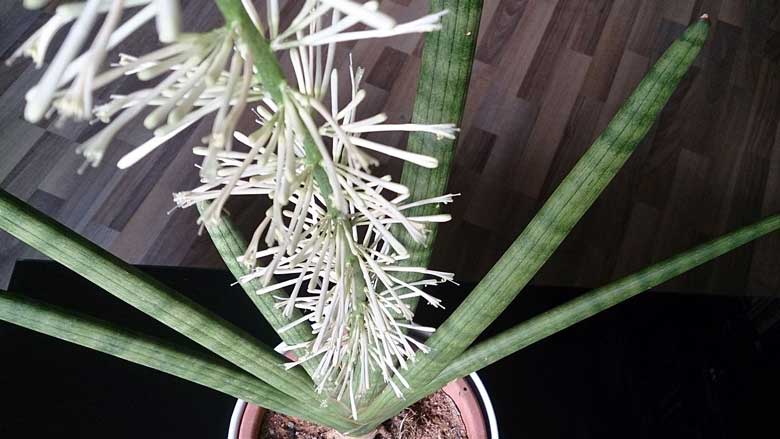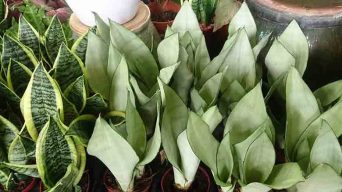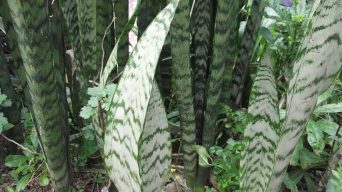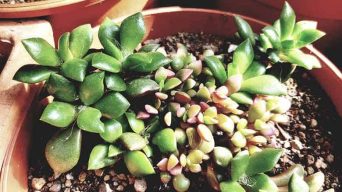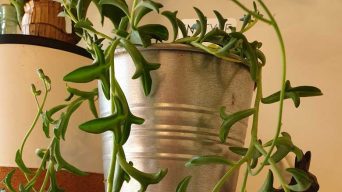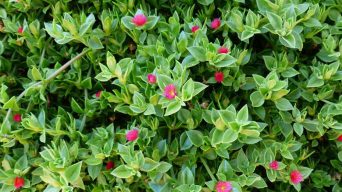Succulents are low-maintenance plants, making them an excellent choice for people without a green thumb.
The Sansevieria cylindrica is the perfect example of a plant that anyone can take care of with minimal effort.
They can withstand long periods of neglect but will flourish when given proper care and attention.
This article will give you an in-depth look at taking care of Sansevieria cylindrica as well as how to propagate your plant(s).
Overview
Sansevieria cylindrica, which has recently been reclassified as Dracaena angolensis, is a succulent native to Angola, located in Southern Africa.
It has fan-shaped, striped elongated dark green-gray subcylindrical leaves that grow up to 3 cm in diameter and 2 meters (7 feet) from a basal rosette.
The Sansevieria cylindrica may produce a 3 foot (90 cm) spike-like raceme of white tubular flowers.
The 3 cm (1 in) greenish-white tubular flowers are tinged with pink.
In addition to being called Dracaena angolensis, Sansevieria cylindrica is also known as:
- African Spear Plant
- Cylindrical Snake Plant
- Spear Sansevieria
- Skyline Spear Sansevieria
- Spear Orchid
- Saint Bárbara Sword
How To Care for Sansevieria Cylindrica (African Spear Plant)
Sansevieria cylindrica care is easy, and this succulent plant is perfect for both beginners and experienced gardeners.
To have a healthy and thriving Sansevieria cylindrica plant, it’s important to understand the basics of how to care for it.
The most important information about caring for Sansevieria cylindrica is included below.
Sun Exposure & Light Requirements
Regarding sun exposure, Sansevieria cylindrica falls somewhere between full sun and part shade.
It does best when given bright, indirect light but can also tolerate some direct sunlight. It needs four to six hours of bright light per day to stay healthy.
If you’re keeping your Sansevieria cylindrica indoors, place it near a west or east-facing window so that it will get some morning or afternoon sun.
When growing your African Spear outdoors, make sure it’s in a spot that gets plenty of sunlight but is also shaded during the hottest part of the day.
If your plant is beginning to show signs of sunburn, such as wilting or browning leaves, it needs to be moved to a shadier spot.
Watering Requirements
Sansevieria cylindrica is a succulent plant that stores water in its leaves and stems. It does not require frequent watering; overwatering can be deadly.
Allow the soil to dry out between waterings. Check the soil moisture by sticking your finger into the soil. If the top inch of soil feels dry, you need to water the plant.
Depending on the humidity and temperature of your environment, you may need to water your Sansevieria cylindrica more or less often.
In general, watering once a week is a good rule of thumb.
Soil Requirements
Sansevieria cylindrica thrives in a well-draining soil mix that is low in nutrients.
You can successfully grow Sansevieria cylindrica in a cactus or succulent mix.
If you want to create your own soil mix, combine two parts potting soil, 1 part coarse sand, and 1 part perlite.
This soil mix will drain well and hold just enough moisture for the Sansevieria cylindrica plant to survive.
If your soil is very heavy, add more sand and perlite to loosen it up.
Whatever you choose, make sure that your growing media drains well and is not too heavy.
Temperature and Humidity
The Sansevieria cylindrica thrives at average room temperature, between 65 and 82 degrees Fahrenheit (18-28 Celsius).
It is advisable to give your plant some cooler temperatures between 45 and 52 degrees Fahrenheit (7-11 Celsius) during the nighttime, allowing for a healthy rest period.
This succulent also needs low humidity levels, ideally at around 40%.
If you live in a high-humidity environment, placing your Sansevieria cylindrica in a room with good air circulation is best.
Fertilizing
The Sansevieria cylindrica plant does not need to be fed much compared to other plants. Feeding your succulents too much can even kill them!
Only fertilize your African Spear succulent during the growing season (spring and summer).
Do not fertilize during fall and winter since this will promote new growth, susceptible to cold weather damage.
Use a balanced liquid fertilizer diluted to half-strength on your Sansevieria cylindrica plant. Only fertilize the soil and not the foliage.
Potting and Repotting
Sansevieria cylindrica can be grown in a pot or container. Use a pot or container with drainage holes and a well-draining potting mix when potting or repotting.
When repotting, using a container approximately 1 or 2 inches larger than the previous pot is best.
Blooming size plants are usually repotted in containers at least 6-8 inches in width and height.
When potting or repotting, be sure not to bury the plant too deep. The top of the soil should be at or just below the level of the plant’s base or crown.
Gently remove the succulent from the old pot and then replant it in a new pot that is only slightly larger.
Also, it is best to spread the roots a little before putting them into a pot with soil and avoid packing the soil too tightly around the plant.
After repotting, remember to not water the plant for a few days to allow the roots to settle in.
Pruning
In general, Sansevieria cylindrica does not require pruning.
However, you can trim the leaves of a Sansevieria cylindrica succulent plant to shape it or add texture to your pot if desired.
You can also cut off leaves that have become too long or dried out.
Removing damaged and dead leaves helps to keep the plant healthy and looking its best.
The leaves can be cut off using scissors or a knife by simply cutting as close to the base of the plant as possible.
Make sure that your tools are disinfected before and after you remove parts from your plant.
Pests and Diseases
Sansevieria cylindrica succulent plants are generally quite hardy and resilient but can be susceptible to some pests and diseases.
Mealybugs and vine weevils are the most common pests, while root rot is the most common disease.
Vine Weevils
Vine weevils are a type of beetle that can be particularly troublesome for succulent plants.
They are small, brownish-black beetles that feed on the leaves and stems of succulents, causing them to wilt and die.
If you notice any wilting or dying succulents, check them for vine weevils.
They can be challenging to get rid of, but there are a few methods that can help.
One is to spray the plants with a strong jet of water to dislodge the beetles, then collect them and dispose of them.
Another is to apply insecticidal soap or neem oil to the leaves. The beetles should die within a day or two.
Mealybugs
Mealybugs are small, soft-bodied insects that can also be a nuisance for succulent plants.
They typically attach themselves to the leaves and stems of plants, where they feed on the sap. Mealybugs can cause wilting and discoloration of leaves.
You can control mealybugs by simply wiping them off with a cotton swab soaked in rubbing alcohol.
Root Rot
Root rot is the most common disease that Sansevieria cylindrica succulent plants can fall victim to. Unfortunately, it is also fairly serious and often fatal.
The roots of affected plants become blackened, mushy, or rotten.
If you suspect your plant has root rot, move it to a brightly-lit location with good air circulation, water it less frequently, and allow the soil to dry out a bit between waterings.
If this doesn’t help, consider repotting it in new soil.
Prevention
To help prevent pests and diseases, be sure to:
- Prune off any damaged or wilted leaves
- Remove any dead or rotting plants
- Dispose of any fallen leaves or debris
- Keep the plant in a bright, sunny location with good air circulation
- Water the plant sparingly, allowing the soil to dry out between waterings
- Repot the plant in new soil every 2-3 years
- Clean and sterilize pots and other containers before reusing them
How to Care for Sansevieria Cylindrica (African Spear Plant) in Winter
Sansevieria cylindrica care in winter is minimal because it goes dormant primarily during this time of year.
The African Spear Plant can’t take cold weather, so you will need to move it inside during winter in the colder climates.
When the temperature drops below 50 degrees Fahrenheit (10 degrees Celsius), you must move your Sansevieria plant inside.
When indoors, keep the plant in a bright, sunny spot and water it sparingly.
In winter, Sansevieria cylindrica should be watered very sparingly as it is going into a dormant state.
Keep the soil mix relatively dry and reduce water even further if the plant is kept in cool conditions.
If your houseplants are not overwatered, they will go through winter without any problems.
Let Sansevieria cylindrica rest and enjoy its beauty during winter. This will help them have a very healthy return in the springtime.
How To Propagate Sansevieria Cylindrica (African Spear Plant)
Sansevieria cylindrica propagation is easy and can be done by division or leaf cuttings.
Division
To propagate Sansevieria cylindrica by division, simply divide the plant into 2-3 sections using a sharp knife or shears.
Each section should have at least one growing point (node) and some roots. Pot each section in its own container filled with moist potting soil.
After a few weeks, new growth will start to emerge, and the new plants are ready to be planted in their own containers.
Leaf Cuttings
To propagate Sansevieria cylindrica by leaf cuttings:
- Take a healthy leaf from the plant and cut it off close to the base.
- Cut the leaf into approximately 4-inch pieces.
- Place the leaf pieces in moist potting soil.
- Make sure the leaf cutting is kept in a warm, sunny spot.
- Water the cutting regularly.
After a few weeks, new growth will start to emerge, and the new plants are ready to be transplanted into their own containers.
Final Thoughts
Succulents make excellent houseplants because they are low maintenance and relatively easy to propagate.
If you are new to succulent care, the Sansevieria cylindrica is an excellent plant to start with. It is hardy and easy to care for and propagates easily from leaf cuttings.
With a little bit of care, you can have a healthy African Spear plant that will thrive for years to come.

